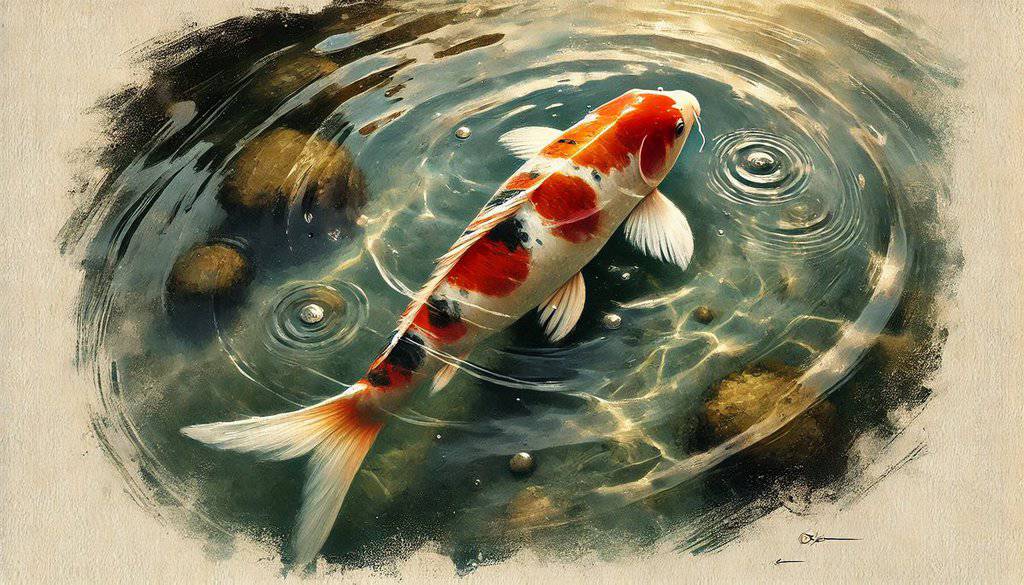Koi is a popular ornamental fish species highly valued in aquaponics systems due to its vibrant colors and cultural significance. These fish are known for their strong growth rates, resilience, and ability to thrive in various aquatic environments[1][3]. Koi’s adaptability and aesthetic appeal make them an attractive choice for both novice and experienced aquaponics practitioners.
Natural Habitat and Behavior
Origin and native environment: Koi are domesticated varieties of the common carp, originally native to East Asia. In the wild, they inhabit slow-moving rivers, lakes, and ponds.
Natural behavior in the wild: Koi are social fish that typically swim in schools. They are known for their bottom-feeding behavior, often sifting through substrate for food.
Temperament: Koi are generally docile and peaceful, making them suitable for community setups[3].
Compatibility: Koi can be kept with other non-aggressive fish species of similar size and temperature requirements. They are often successfully combined with plants like lettuce and water spinach in aquaponics systems[3].
Water Requirements
Temperature Range:
- Ideal temperature: 18-25°C (64.4-77°F)
- Temperatures outside this range can stress the fish and affect their growth and immune system
pH Level:
- Recommended pH range: 6.0-8.0
- Koi are relatively tolerant to pH fluctuations, but stability is crucial for their health[2]
Water hardness:
- Koi prefer moderately hard water with a range of 100-250 ppm (parts per million)
Oxygen Levels:
- Ideal dissolved oxygen levels: Above 5 mg/L
- Koi have a moderate tolerance to low oxygen conditions but require well-aerated water for optimal health
Ammonia/Nitrate Sensitivity:
- Koi are sensitive to ammonia and nitrite spikes
- Maintain ammonia and nitrite levels close to 0 mg/L, and nitrate levels below 50 mg/L[2]
Tank or Pond Setup
Tank/Pond Size Requirements:
- Minimum recommended size: 1000 liters (264 gallons) for a small group
- Allow at least 250 liters (66 gallons) per adult koi
Filtration & Aeration:
- Koi require efficient filtration and strong aeration due to their size and waste production
- In aquaponics systems, ensure adequate water circulation and plant filtration capacity[4]
Lighting Considerations:
- Koi benefit from natural light cycles, but avoid excessive direct sunlight to prevent algae overgrowth
Tank Decorations/Substrate:
- Smooth gravel or sand substrate can be used, but is not essential
- Include plants, rocks, or other structures for hiding and exploration
Feeding Requirements
Diet:
- Omnivorous, accepting a variety of foods
- Commercial koi pellets supplemented with vegetables, fruits, and occasional live foods
Feeding Techniques:
- Feed 2-3 times daily, offering only what they can consume in 5 minutes
- Adjust feeding based on water temperature and fish activity
Supplements or special diets:
- Consider supplementing with vitamins and color-enhancing foods to maintain vibrant coloration
Growth and Reproduction
Growth Rate:
- Koi grow rapidly, reaching 15-20 cm (6-8 inches) in their first year
- Can grow up to 60-90 cm (24-36 inches) at maturity
Physical Growth Indicators:
- Color intensifies with age
- Body shape becomes more elongated and streamlined
Breeding Behavior:
- Breeding typically occurs in spring when water temperatures rise
- Provide spawning mops or aquatic plants for egg deposition
Care of Fry:
- Separate fry from adults to prevent predation
- Adding lots of hiding places can also help some fry to survive.
- Feed newly hatched fry with infusoria, gradually transitioning to powdered fry food
Harvesting & Culinary Considerations
As koi are primarily ornamental fish, they are not typically harvested for culinary purposes in aquaponics systems.
Pros and Cons in Aquaponics Systems
- Efficient nutrient cycling, contributing to plant growth[2][3]
- Aesthetically pleasing and culturally significant
- Adaptable to various system sizes
- Require larger system volumes due to their size
- May uproot or disturb certain plant species
Overall Suitability: Best for intermediate to experienced aquaponics practitioners with larger systems
Common Health Issues and Solutions
Potential Diseases:
- Koi are susceptible to various bacterial, fungal, and parasitic infections
- Common issues include fin rot, ich, and koi herpesvirus (KHV)
Signs of Health Issues: Abnormal swimming behavior, loss of appetite, visible lesions or spots on the body
Treatment Recommendations:
- Maintain optimal water quality through regular testing and adjustments
- Quarantine new fish before introduction to the main system
- Consult a fish veterinarian for specific treatment options if issues arise
Maintenance Tips for Long-Term Health
Maintenance Frequency:
- Perform weekly water quality tests and partial water changes
- Regularly clean filters and remove excess debris
System checks:
- Monitor temperature, pH, ammonia, nitrite, and nitrate levels daily
- Ensure proper functioning of filtration and aeration equipment
Handling Practices:
- Minimize handling to reduce stress
- Use soft nets when necessary and support the fish’s body when out of water
Winter/Summer Care:
- Provide additional aeration during summer months
- In colder climates, consider moving koi to indoor systems or using heaters during winter
Tank Compatibility and Stocking:
- Koi are generally compatible with a wide range of aquaponic plant species[2][3]
- Stock conservatively, allowing for growth and maintaining adequate filtration capacity
Closing Thoughts
Koi are an excellent choice for aquaponics enthusiasts seeking a visually striking and culturally significant fish species. Their adaptability, strong growth rates, and compatibility with various plants make them well-suited for medium to large-scale aquaponics systems. However, their size and specific care requirements demand careful planning and management. By providing optimal water conditions, appropriate nutrition, and regular maintenance, aquaponics practitioners can enjoy the beauty and benefits of koi while maintaining a thriving ecosystem.
Other fish species for aquaponics
External sources:
[1] https://www.semanticscholar.org/paper/9819e504179f03ad844671ec2c0774921910dbb4
[2] https://www.semanticscholar.org/paper/2bd75d8cc698ab962e5a155c81f85adbb585eb76
[3] https://www.semanticscholar.org/paper/55c2ba1db96ba83b393cb8bb1c093224347606b3
[4] https://www.semanticscholar.org/paper/074e8aed196acc1fe598effa35778e2234941c7a
[5] https://www.semanticscholar.org/paper/857a069d503ef5f868e6bba0f1647a41a981814c

